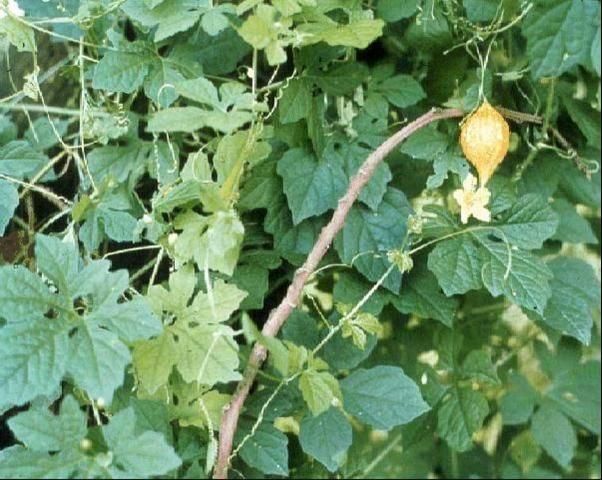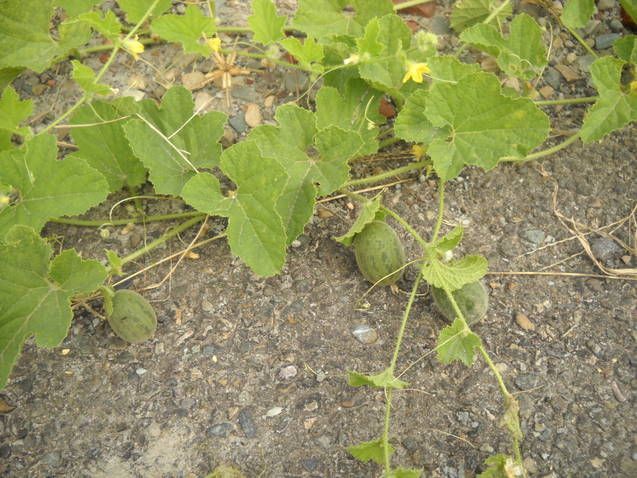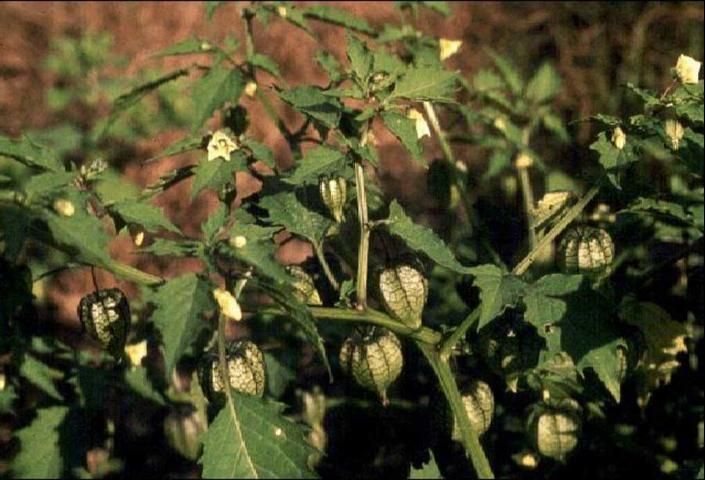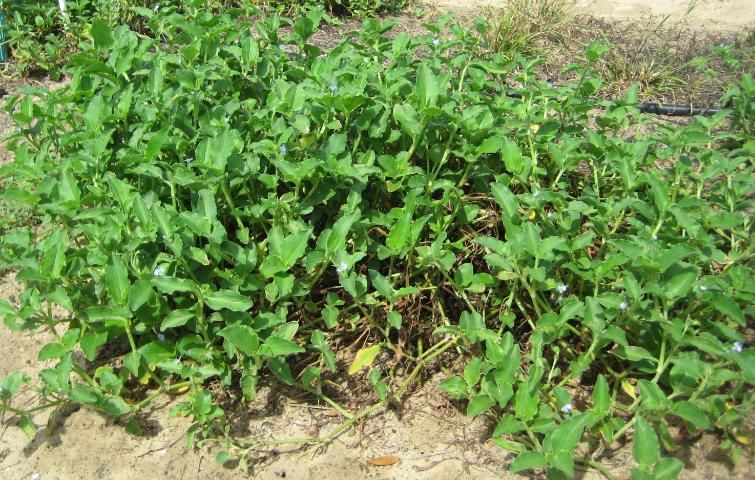Weed growth can severely decrease the commercial, recreational, and aesthetic values of crops, landscapes, and waterways. More information on weeds can be found in Hall et al. (2009i). Other than affecting crop production by reducing the amount of nutrients available to the main crop, weeds can also influence crop production by acting as reservoirs of various viruses that are transmitted by insects. Several insects transmit different viruses in different crops, but aphids and whiteflies are among the most important virus vectors (carriers of viruses) on vegetable crops in Florida. The insect vectors feed on various parts of weeds that are infected by a virus and acquire the virus in the process. They then can feed on uninfected agricultural crops and transmit the virus to them. Insects are often attracted to weeds and survive on them because weeds can provide food for insects when preferred food is scarce, or weeds can provide shelter from adverse conditions such as bad weather or pesticide applications. Several weeds have been reported as virus hosts by Kucharek and Purcifull (2001). The current publication includes additional and updated material since that time and provides links to further information on specific viruses that affect vegetable crops. Certain volunteer vegetable plants can also act as sources of viruses that endanger the main crop.
Information on weed hosts of various vegetable viruses can be found in Table 1. Virus names are often based on the name of the vegetable they attack; however, certain viruses affect many different vegetables, e.g., Cucumber mosaic virus attacks bell pepper, tomato, spinach, cantaloupe, cucumber, pumpkin, squash, celery, and watercress. References to appropriate publications are provided for easy cross-reference and more details about the virus under consideration. Common viruses with their family and genus names are provided in Table 2. Information is also provided for each vegetable that was reported infected by the virus, and on the insect vectors that transmit the virus. Some viruses, such as Tomato mosaic virus, are not transmitted by vectors. Others, such as Bean common mosaic virus, can be transmitted by vectors or through seed. Detailed information about viruses and their transmission has been summarized by Adams and Antoniw (2011). Common and scientific names of weeds that act as virus sources are listed in Table 3.
Removal of weeds that act as virus sources may be helpful in reducing the initial infestation by a virus of the main crop in the same field as well as other fields that are near the weeds. Removal of volunteer plants from field borders may also help in management of viral diseases (Momol and Pernezny 2006).
While a number of weeds in and around fields of different crops can act as virus sources for the main vegetable crop, some of them are particularly important because of their ability to host a number of different viruses. A few of these are balsam apple (Figure 1), creeping cucumber (Figure 2), groundcherry (Figure 3), dayflower (Figure 4), American black nightshade (Figure 5), hairy indigo (Figure 6), and citron (Figure 7). The American black nightshade is common in Florida (MacRae 2010), and it is possible that some of the references to "nightshade" in Table 1 or to "black nightshade" may actually refer to this plant. Recognition of these common virus host plants is important because they may be reservoirs for viruses, allowing them to survive during the off-season when the main vegetable crops are not grown.

Credit: Brent Sellers (Hall et al. 2009a), UF/IFAS

Credit: Gaurav Goyal, UF/IFAS

Credit: Brent Sellers (Hall et al. 2009b), UF/IFAS

Credit: Gaurav Goyal, UF/IFAS

Credit: Gaurav Goyal, UF/IFAS

Credit: Robert McSorley, UF/IFAS

Credit: Gaurav Goyal, UF/IFAS
References Cited
Adams, M. J., and J.F. Antoniw. 2011. "Descriptions of plant viruses." Association of Applied Biologists, Rothamsted Research, Harpenden, UK. https://www.dpvweb.net
Adkins, S., and E. N. Rosskopf. 2002. "Key West nightshade, a new experimental host for plant viruses." Plant Disease 86:1310–1314.
Adkins, S., S. E. Webb, C. A. Baker, and C. S. Kousik. 2008. "Squash vein yellowing virus detection using nested polymerase chain reaction demonstrates that the cucurbit weed Momordica charantia is a reservoir host." Plant Disease 92:1119–1123.
Adkins, S., S. E. Webb, P. D. Roberts, C. S. Kousik, P. A. Stansly, B. D. Bruton, D. Achor, R. M. Muchovej, and C. A. Baker. 2010. A review of Ipomoviruses and Watermelon decline in Florida, pp. 333–337. In P.A. Stansly and S.E. Naranjo (eds.), Bemisia: Bionomics and management of a global pest. Springer Publishing, New York.
Baker, C., S. Webb, and S. Adkins. 2008. Squash vein yellowing virus, causal agent of watermelon vine decline in Florida. Plant Pathology Department Circ. 407. Florida Dept. of Agriculture and Consumer Services, Division of Plant industry, Gainesville, FL.
Bracero, V., and L. I. Rivera. 2003. "DNA analysis confirms Macroptilium lathyroides as alternative hosts of bean golden yellow mosaic virus." Plant Disease 87:1022–1025.
Brown, L. G., and G. W. Simone. 1994. Tomato yellow leaf curl geminivirus. Plant Pathology Circ. 366. Florida Dept. of Agriculture and Consumer Services. Division of Plant Industry, Gainesville, FL. http://www.freshfromflorida com/pi/enpp/pathology/pathcirc/pp366.pdf
Dikova, B. 1946. "Establishment of tobacco rattle virus (trv) in weeds and Cuscuta." Biotechnology and Biotechnology Equipment 20:42–48.
Ferreira, S. A., and R. A. Boley. 1992. Cucumber mosaic virus. Crop Knowledge Master. Department of Plant Pathology, CTAHR, University of Hawaii, Manoa. http://www.extento.hawaii.edu/kbase/crop/type/cucvir.htm
Ferrell, J. A., G. E. MacDonald, and B. J. Brecke. 2009. Benghal Dayflower (Commelina benghalensis L.), Identification and Control. SS-AGR-223. Gainesville: University of Florida Institute of Food and Agricultural Sciences. https://edis.ifas.ufl.edu/publication/ag230
Fukumoto F., F. Terami, and M. Ishii. 1993. Zucchini yellow mosaic virus isolated from wax gourd (Benincasa hispida Cogn.) and balsam pear (Momordica charantia L.) (in Japanese). Proceedings of Kanto Plant Protection Society 40:101–103.
Gilman, E. F. 2011. Asclepias curassavica Butterflyweed, Milkweed, Silkweed. FPS-49. Gainesville: University of Florida Institute of Food and Agricultural Sciences. https://edis.ifas.ufl.edu/publication/fp049
Groves, R. L., J. F. Walgenbach, J. W. Mayor, and G. G. Kennedy. 2002. "The role of weed hosts and Tobacco thrips, Frankliniella fusca, in the epidemiology of tomato spotted wilt virus." Plant Disease 86:573–582.
Hall, D., V. V. Vandiver, and B. A. Sellers. 2009a. Balsam-Apple, Momordica charantia L. Excerpt from Weeds in Florida. SP 37. Gainesville: University of Florida Institute of Food and Agricultural Sciences. https://edis.ifas.ufl.edu/fw028
Hall, D. W., V. V. Vandiver, and B. A. Sellers. 2009b. Cutleaf Ground-Cherry, Physalis angulata L. Excerpt from Weeds in Florida. SP 37. Gainesville: University of Florida Institute of Food and Agricultural Sciences. https://edis.ifas.ufl.edu/fw031
Hall, D. W., V. V. Vandiver, and J. A. Ferrell. 2009c. Horse-Nettle, Solanum carolinense L. Excerpt from Weeds in Florida. SP 37. Gainesville: University of Florida Institute of Food and Agricultural Sciences. https://edis.ifas.ufl.edu/fw040
Hall, D. W., V. V. Vandiver, and J. A. Ferrell. 2009d. Jimson Weed, Datura stramonium L. Excerpt from Weeds in Florida. SP 37. Gainesville: University of Florida Institute of Food and Agricultural Sciences. https://edis.ifas.ufl.edu/fw016
Hall, D. W., V. V. Vandiver, and J. A. Ferrell. 2009e. Lamb's Quarters (Common lamb's-quarters), Chenopodium album L. Excerpt from Weeds in Florida. SP 37. Gainesville: University of Florida Institute of Food and Agricultural Sciences. https://edis.ifas.ufl.edu/fw011
Hall, D. W., V. V. Vandiver, and J. A. Ferrell. 2009f. Sicklepod, Senna obtusifolia L. Excerpt from weeds in Florida. SP 37. Gainesville: University of Florida Institute of Food and Agricultural Sciences. https://edis.ifas.ufl.edu/fw007
Hall, D. W., V. V. Vandiver, and J. A. Ferrell. 2009g. Wild Radish, Raphanus raphanistrum L. Excerpt from weeds in Florida. SP 37. Gainesville: University of Florida Institute of Food and Agricultural Sciences. https://edis.ifas.ufl.edu/fw032
Hall, D. W., V. V. Vandiver, and J. A. Ferrell. 2009h. Common Beggar's-Tick (Hairy Beggar's-tick), Bidens alba (L.) DC. Excerpt from weeds in Florida. SP 37. Gainesville: University of Florida Institute of Food and Agricultural Sciences. https://edis.ifas.ufl.edu/fw005
Hall, D. W., V. V. Vandiver, and J. A. Ferrell. 2009i. Weeds in Florida: Introduction. Excerpt from weeds in Florida. SP 37. Gainesville: University of Florida Institute of Food and Agricultural Sciences. https://edis.ifas.ufl.edu/fw001
Jenner, C. E., and J. A. Walsh. 1996. "Pathotypic variation in turnip mosaic virus with special reference to European isolates." Plant Pathology 45:848–856.
Johnson, C. S. 2011. Tobacco. Disease and Nematodes: Tobacco. Department of Plant Pathology, Southern Piedmont, AREC. http://pubs.ext.vt.edu/456/456-016/Section_3_Diseases_and_Nematodes-6.pdf
Koike, S. T., and R. M. Davis. 2009. Lettuce mosaic virus. UC IPM Pest Management Guidelines. Agriculture and Natural Resource, University of California. https://www2.ipm.ucanr.edu/agriculture/lettuce/lettuce-mosaic/
Kucharek, T., and D. Purcifull. 2001. Aphid-transmitted viruses of cucurbits in Florida. Plant Pathology Department Circ. 1184. Gainesville: University of Florida Institute of Food and Agricultural Sciences. (http://plantpath.ifas.ufl.edu/takextpub/FactSheets/circ1184.pdf [1 April 2013]).
Kucharek, T., D. Purcifull, and E. Hiebert. 1996. Viruses that have occurred naturally in agronomic and vegetable crops in Florida. Extension Plant Pathology Report no. 7, Plant Protection Pointers. Gainesville: University of Florida Institute of Food and Agricultural Sciences. https://edis.ifas.ufl.edu/pdffiles/PG/PG10100.pdf [26 March 2013]).
Larson, B. C., M. A. Mossler, and O. N. Nesheim. 2011. Florida Crop/Pest Management Profile: Watermelon. CIR 1236. Gainesville: University of Florida Institute of Food and Agricultural Sciences. https://edis.ifas.ufl.edu/publication/pi031
MacRae, A. W. 2010. American Black Nightshade Biology and Control in Fruiting Vegetables, Cucurbits, and Small Fruits. HS 1176. Gainesville: University of Florida Institute of Food and Agricultural Sciences. https://edis.ifas.ufl.edu/publication/hs1176
McGovern, R. J., J. E. Polston, G. M. Danyluk, E. Hiebert, A. M. Abouzid, and P. A. Stansly. 1994. "Identification of a natural weed host of tomato mottle geminivirus in Florida." Plant Disease 78:1102–1106.
Momol, T., and K. Pernezny. 2006. Florida Plant Disease Management Guide: Tomato. PDMG-V3-53. Gainesville: University of Florida Institute of Food and Agricultural Sciences. https://edis.ifas.ufl.edu/pg059
Momol, T., R. Raid, and T. Kucharek. 2005. Florida plant disease management guide: Crucifers. PDMG-V3-37. Gainesville: University of Florida Institute of Food and Agricultural Sciences. https://edis.ifas.ufl.edu/pg045
Mossler, M. A. 2010. Florida crop/pest management profile: Muskmelon. CIR 1272. Gainesville: University of Florida Institute of Food and Agricultural Sciences. https://edis.ifas.ufl.edu/pi047
Mossler, M. A., B. C. Larson, and O. N. Nesheim. 2010. Florida Crop/Pest Management Profiles: Celery. CIR 1235. Gainesville: University of Florida Institute of Food and Agricultural Sciences. https://edis.ifas.ufl.edu/pi035
Mossler, M. A., B. C. Larson, and O. N. Nesheim. 2011. Florida Crop/Pest Management Profile: Cabbage. CIR 1256. Gainesville: University of Florida Institute of Food and Agricultural Sciences. https://edis.ifas.ufl.edu/publication/pi042
Mossler, M. A., and O. N. Nesheim. 2011. Florida Crop/Pest Management Profile: squash. CIR 1265. Gainesville: University of Florida Institute of Food and Agricultural Sciences. https://edis.ifas.ufl.edu/pi046
Newman, Y. C., A. R. Blount, and J. Vendramini. 2010a. Alyceclover—Summer Annual Legume. SS-AGR-47. Gainesville: University of Florida Institute of Food and Agricultural Sciences. https://edis.ifas.ufl.edu/publication/ds123
Newman, Y. C., J. Vendramini, and A. R. Blount. 2010b. Minor Use Summer Annual Forage Legumes. SS-AGR-79. Gainesville: University of Florida Institute of Food and Agricultural Sciences. https://edis.ifas.ufl.edu/ag156
Orsenigo, J. R., and T.A. Zitter. 1971. "Vegetable virus problems in south Florida as related to weed science." Proceedings of the Florida State Horticultural Society 84: 168–171.
Pernezny, K., and R. Raid. 2008. Florida Plant Disease Management Guide: Lettuce and Endive. PDMG-V3-40. Gainesville: University of Florida Institute of Food and Agricultural Sciences. https://edis.ifas.ufl.edu/pg048
Raid, R., and Kucharek, T. 2006a. Florida Plant Disease Management Guide: Celery. PDMG-V3-36. Gainesville: University of Florida Institute of Food and Agricultural Sciences. https://edis.ifas.ufl.edu/pg044
Raid, R., and T. Kucharek. 2006b. Florida Plant Disease Management Guide: Spinach. PDMG-V3-48. Gainesville: University of Florida Institute of Food and Agricultural Sciences. https://edis.ifas.ufl.edu/pg054
Rodríguez-Alvarado, G., S. Fernandez-Pavia, R. Creamer, and C. Liddell. 2002. "Pepper mottle virus causing disease in Chile peppers in southern New Mexico." Plant Disease 86:603–605.
Sellers, B. 2011. Mexican Prickly Poppy: Biology and Control.SS-AGR-304. Gainesville: University of Florida Institute of Food and Agricultural Sciences. https://edis.ifas.ufl.edu/publication/ag311
Sellers, B., and J. Ferrell. 2010. Thistle Control in Pastures. SS-AGR-95. Gainesville: University of Florida Institute of Food and Agricultural Sciences. https://edis.ifas.ufl.edu/publication/ag253
Sellers, B., J. Ferrell, J. Mullahey, and P. Hogue. 2010. Tropical Soda Apple: Biology, Ecology and Management of a Noxious Weed in Florida. SS-AGR-77. Gainesville: University of Florida Institute of Food and Agricultural Sciences. https://edis.ifas.ufl.edu/publication/uw097
Sikora, E. J. 1998. Virus Disease of Tomato. Alabama Cooperative Extension System ANR-836. Department of Plant Pathology. Alabama A & M and Auburn Universities. http://www.aces.edu/pubs/docs/A/ANR-0836/ANR-0836.pdf
Stephens, J. M. 2009a. Chicory—Cichorium intybus L. HS580. Gainesville: University of Florida Institute of Food and Agricultural Sciences. https://edis.ifas.ufl.edu/publication/mv047
Stephens, J. M. 2009b. Citron—Citrullus lanatus (Thumb.) Mansf. Var. citroides (Bailey) Mansf. HS 585. Gainesville: University of Florida Institute of Food and Agricultural Sciences. https://edis.ifas.ufl.edu/publication/mv052
Stephens, J. M. 2009c. Nasturtium, Garden—Tropaeolum majus L. HS632. Gainesville: University of Florida Institute of Food and Agricultural Sciences. https://edis.ifas.ufl.edu/publication/mv099
Stephens, J. M. 2009d. Pokeweed—Phytolacca americana. HS 648. Gainesville: University of Florida Institute of Food and Agricultural Sciences. https://edis.ifas.ufl.edu/publication/mv115
Stephens, J. M. 2009e. Amaranth—Amaranthus spp. HS539. Gainesville: University of Florida Institute of Food and Agricultural Sciences. https://edis.ifas.ufl.edu/publication/mv006
Webb, S. E., D. J. Schuster, P. A. Stansly, J. E. Polston, S. Adkins, C. Baker, P. Roberts, O. Liburd, T. Nyoike, E. McAvoy, and A. Whidden. 2011. Recommendations for Management of Whiteflies, Whitefly-Transmitted Viruses, and Insecticide Resistance for Production of Cucurbit Crops in Florida. ENY-478. Gainesville: University of Florida Institute of Food and Agricultural Sciences. https://edis.ifas.ufl.edu/publication/in871
Webb, S. E., F. Akad, T. W. Nyoike, O. E. Liburd, and J. E. Polston. 2010. Whitefly-Transmitted Cucurbit Leaf Crumple Virus in Florida. ENY-477. Gainesville: University of Florida Institute of Food and Agricultural Sciences. https://edis.ifas.ufl.edu/publication/in716
Zitter, T. A., and M. L. Daughtrey. 1989. Virus diseases and disorders of tomato. Coop. Ext. Fact Sheet 735.40. Dept. of Plant Pathology, Cornell Univ., Ithaca, NY. http://vegetablemdonline.ppath.cornell.edu/factsheets/Viruses_Tomato.htm
Zitter,T.A., and R. Provvidenti. 1984. Vegetable crops: Virus diseases of leafy vegetables and celery. Vegetable MD Online, Coop. Ext. Fact Sheet 737.00. Dept. of Plant Pathology, Cornell Univ., Ithaca, NY. http://vegetablemdonline.ppath.cornell.edu/factsheets/Viruses_LeafyVege.htm
Table 1. Weed hosts of several important vegetable viruses in Florida.
Table 2. Common viruses, families, vegetable crop hosts, and their vectors.
Table 3. Common and scientific names of various weed hosts of viruses.